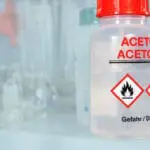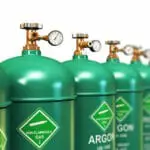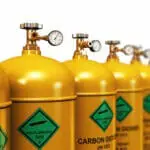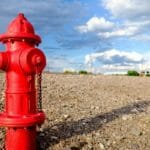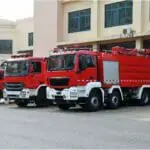We all hope that we will never find ourselves in a situation where we are standing outside a burning building, engulfed in flames, waiting for the fire brigade to arrive.
If you have been in this situation in the past, you know how scary and traumatic it can be to witness with your own two eyes.
No matter how big or small the flames may be, it is never fun to see with your own two eyes. Usually the firefighters arrive within a couple of minutes, and depending on the size of the fire, it may take some time to completely extinguish the flames.
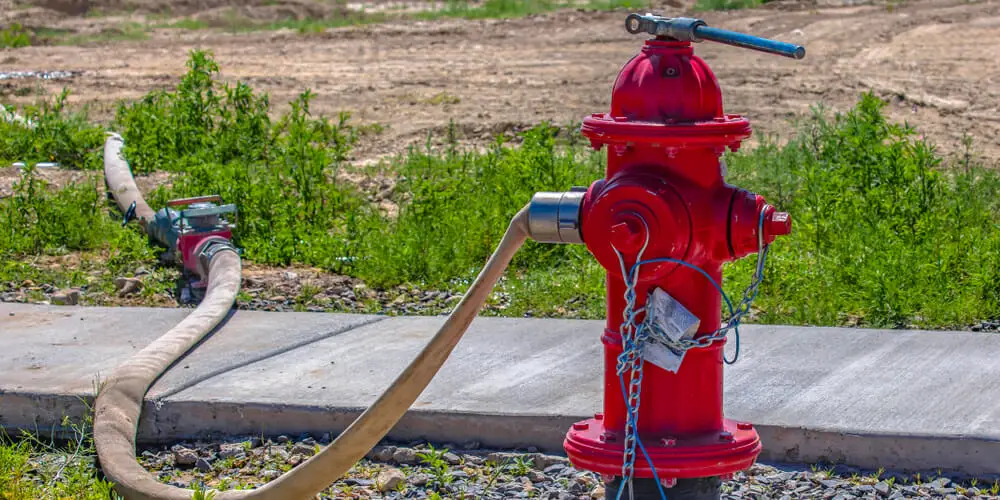
When I was a kid, I thought that firemen would hook their hoses into the fire engine that they arrived in, and that the vehicle was magically filled with an unlimited supply of water to put the fire out.
It was later on in life that I worked out, through logic, that this was not true, and discovered that fire engines only contain around a thousand gallons of water to be used in emergency situations.
While this may seem like a lot of water, the firemen may run out if the fire is particularly big: after all, fires spread very quickly, and if the building is large enough, it will take a lot more water to extinguish the flames.
These are the kind of situations in which firefighters will begin searching for the nearest fire hydrant to rely on for additional support.
Unlike us average citizens, firefighters are usually trained to know exactly where to find a fire hydrant, no matter what location they have been sent to.
This is essential if their current task is to put out a huge, wild-spreading fire.
It may be wise, however, for you to learn where your nearest fire hydrant is: while it may seem like something you do not need to know, as you won’t be the one using it, it would still be helpful to save time and point the firemen in that direction if they are unaware of the nearest hydrant’s location.
If you don’t know where your nearest fire hydrant is, and you would like to find out for safety purposes, you have come to the right place.
Today, we are going to not only teach you how to find your nearest hydrant, but also how you can swiftly find one wherever you are in the world. There are always signs that will point you in the right direction, but only if you know what you are looking for.
Continue reading this article to find out our 8 different, fail proof ways to find your nearest fire hydrant.
What Is A Fire Hydrant?
If you do not know what a fire hydrant is, reading this article may feel pretty futile. How are you supposed to find your nearest one if you don’t even know what it is, or what it looks like?
For this reason, we are going to start at the very beginning, just so that everyone reading is caught up to date.
So, what is a fire hydrant?
A fire hydrant is a, essentially, a point which is linked to several underground pipes, including those connected to the local water supply.
It is usually a metal pillar sticking out of the ground, but sometimes it can be underground. Fire hydrants display several different appearances depending on what job they are specifically needed for, ranging in a wide variety of colors.
Pillar-type fire hydrants have entry points which firefighters can use to attach and connect their fire hoses, so they can quickly gain access to the water supply in the case of a fire.
Underground fire hydrants work a little differently: these are covered by a lid, and require a particular kind of key to unlock and lift it up, allowing the hydrant to be used.
Depending on where you are from, there should be different types of signs that will point you, or the fire brigade, towards the nearest fire hydrant. There should be a handful of hydrants in your area, but again, it depends what area you live in.
Luckily for you, firefighters are thoroughly trained to locate the fire hydrants in the areas which they work in, and have spent a lot of time researching where each one is hidden throughout your town, city, or district.
Even if you do not know where your nearest hydrant is, the fire brigade called to your emergency will most likely already know where to find it.
However, as we said before, this does not mean that you shouldn’t learn where your nearest one is. In the rare case that the firefighters may not know where to find one, you may be able to save time by pointing them in the right direction.
While fire hydrants are best known for being used to extinguish fires, they are also used for a number of other purposes: they may be used as a cleaning source for sewers, streets, or commercial construction work, or they may be used for main distribution line flushing. They can also be used to test the hydraulic output of the distribution system.
What Does A Fire Hydrant (Typically) Look Like?
So, to recap what we mentioned in the previous section, there are two types of fire hydrants: underground hydrants, and above-ground metal pillar hydrants. The appearance of these devices depend on where you are located in the world.
Underground fire hydrants are often used in the UK, Spain, Germany, and several other countries throughout Europe. They are usually locked underneath a metal cover and are required to be opened with a special key, meaning that not just anyone can open them up.
These covers will have written engraved into the metal, allowing the public to be able to identify that these flat pieces of metal are the openings to an underground fire hydrant.
These are quite tricky to find around your area if you are unsure where to look, but they are highly identifiable once you have stumbled upon one. There will also be certain signs around this area that will point you in the direction of the fire hydrant (more on that later).
In some places around the world, mainly the US, the hydrants are above-ground pillar types that stand roughly around three-feet tall, and range between six different colors: light blue, green, orange, red, yellow, and purple.
While most of the fire hydrants nowadays are colored bright yellow, making them easily visible from far away distances, each of these colors have different meanings, displaying what specific functions and purposes these hydrants should be used for.
Light Blue
A light blue fire hydrant, otherwise known as a Class AA hydrant, usually indicates a flow capacity of over 1,500 gallons per minute. These hydrants include the highest flow volume compared to the other colors.
Green
A green fire hydrant, otherwise known as a Class A hydrant, indicates a flow capacity of around 1,000 to 1,499 gallons per minute.
Orange
An orange fire hydrant, otherwise known as a Class B hydrant, indicates a flow capacity of around 500 to 999 gallons per minute.
Red
A red fire hydrant, otherwise known as a Class C hydrant, indicates a flow capacity of 499 (or less) gallons per minute. These hydrants usually include the lowest flow volume compared to the other colors mentioned.
Yellow
A yellow fire hydrant indicates that the water provided will be directly extracted from your local public supply system.
Purple/Violet
A purple or violet fire hydrant indicates that the water provided will be directly extracted from a lake or a pond, or some other natural body of water.
While the color schemes may differ depending on where you are from, the main thing that matters when it comes to fire hydrants is that they are a bright color, allowing them to be clearly visible from far distances.
They are all connected to water supplies, and they all produce water once activated, therefore they can all be used in the case of an emergency fire.
While the specific color may not technically matter all that much in the midst of an emergency situation, it still is useful to remember each use and purpose for the chosen color codes in your area for future reference.
8 Ways To Find Your Nearest Fire Hydrant
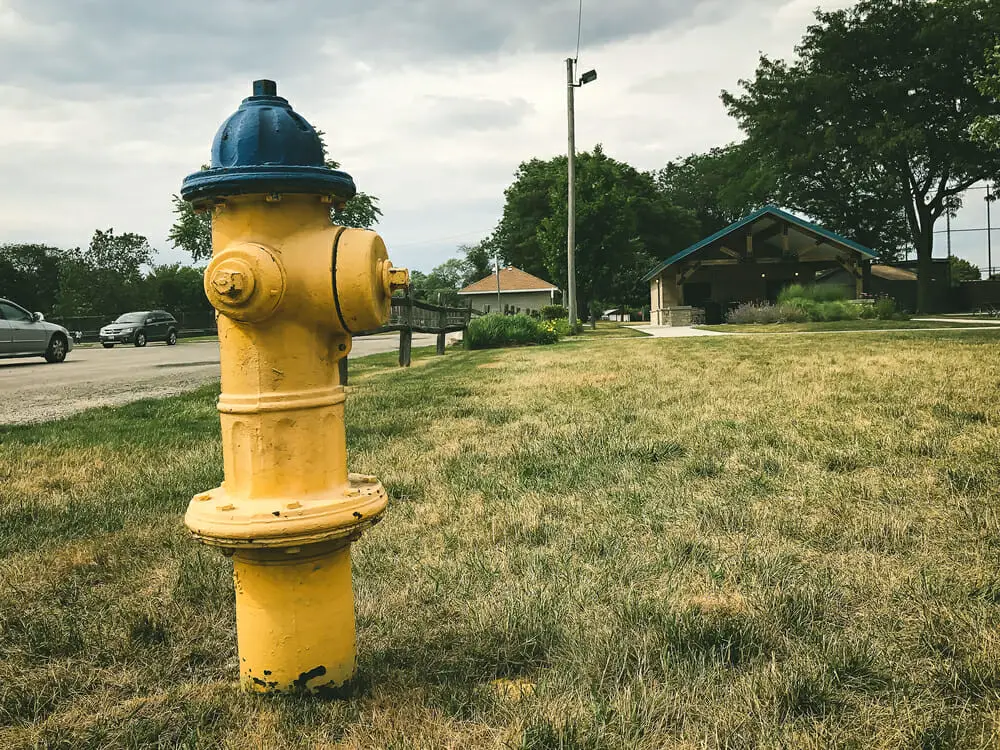
It is now time to return to the question suggested in the title of this article. Now that we know what a fire hydrant looks like, how do we know where to find them?
Below, we have listed 8 different ways that you can find your nearest fire hydrant in the case of an emergency. This is always useful to know, as you never know when this information may come in handy.
In the list, there will be several points that relate directly to a specific area or country in the world, but we have also listed points that anyone can use, no matter where they are from.
If you do not see your own country in this list at first, don’t worry: there are options that anyone can use towards the end of the list.
So, here are 8 ways to find your nearest fire hydrant. Let’s get into it.
Look Out For Blue Street Reflectors Along The Road (US)
Let’s start with how to find fire hydrants in the United States.
One of the many ways you can find one of your local fire hydrants is by looking out for blue street reflectors on the road, usually placed around six inches away from the middle of the street. These are small, blue squares that are roughly sized 4’’ by 4’’.
They are placed on the side of the street closest to the fire hydrant, so it should be pretty simple to find it just by searching around the surrounding area.
Street reflectors are designed to be highly visible by those driving down the street at night: the beams shone from the car’s front lights will reflect off the blue squares, instantly making themselves visible.
During the day, they can be found if you simply search for those little blue markers along the road.
Check Lamp Posts For A Yellow ‘H’ (UK)
If you find yourself searching for a fire hydrant in the United Kingdom, it is actually pretty straightforward compared to some other countries.
As we previously mentioned, British fire hydrants are all found underground, so it is a little more difficult to locate them compared to the brightly colored pillars that you would find in America.
However, due to this, the signs that lead you to the hydrants are a lot more obvious and easily visible compared to ones in other countries. In the UK, there will be yellow signs nailed onto lamp posts, or, sometimes, other items, that will direct you towards the nearest hydrant.
These signs are square shaped, bright yellow, and have a bold, black letter ‘H’ (for ‘hydrant’) written on it, along with two numbers: the number below the ‘H’ will let you know your distance from the hydrant, and the number above indicates the measurement of the connecting valve.
Look Out For Red-Bordered Marker Plates Alongside The Road (Germany)
Finding a fire hydrant in Germany is fairly similar to trying to find one in the UK: both countries mainly use underground hydrants, making it considerably more difficult to spot them from far distances.
In Germany, white square signs with red borders are placed alongside the road, not too far away from fire hydrants. These signs will be placed on posts on the sidewalk, clearly visible to those passing.
There should be a black T-shaped symbol on the sign, and not unlike the UK signs, they also display the distance from the fire hydrant as well as the gauge of the connecting valve.
Look Out For Blue Cat’s Eyes Along The Road (Australia)
In Australia, the fire hydrants are often above ground and highly visible. Compared to the ones used in America, however, they are quite a bit thinner and longer, maintaining a pipe appearance compared to a shorter, stumpier pillar.
If you are searching for a fire hydrant in Australia, the signs that will point you in the right direction are actually quite similar to those used in the US: Australians will have to follow ‘cat’s eyes’, which are very much the same as American street reflectors.
They are easily seen while driving at night, due to the car’s lights automatically reflecting off of the cat’s eyes ahead of them. These small squares along the road will also be colored blue if they are indicating that there is a fire hydrant nearby.
Cat’s eyes are also used in the UK, but mainly to guide those driving in the dark along the road, helping those to navigate particularly tricky roads with a lot of turns. Australia also uses cat’s eyes for this reason, but they will use different colors for different purposes.
Look Out For Triangular Markers Along The Road (Australia)
Australians will also follow triangular markers in order to identify the location of a nearby fire hydrant.
These markers are painted onto the road, and are colored with bright yellow paint to ensure that they are as visible as possible.
The triangles point towards the direction of the fire hydrant, and are often paired alongside other forms of indicators, such as a sign, or the previously mentioned cat’s eyes.
The reason these triangle shaped markers are not often used alone anymore is because they are not very clearly visible, as you can only see them if you are looking down at the road.
Google Search Your Nearest Fire Hydrant (Worldwide)
This may be one of the easiest options for those who have no idea what signs to search for, whether they are in their own local area or navigating through a foreign country.
If you have a cell phone, and you have the ability to use a wireless connection to access the internet, the best thing you can do is use Google (or whichever your preferred search engine is) to simply search up where your nearest fire hydrant can be located.
There are several sites that will be able to aid you through this process, so it shouldn’t be too difficult, providing you have an internet connection. This option will work wherever you are in the world: you will just need to know the details of your current address.
Where would we be without our phones, huh? We can’t imagine how much harder this whole ordeal would have been twenty years ago.
Use An App (Worldwide)
Next up, here is yet another solution to be used through our phones.
There are several apps to be found that will actually tell you where your nearest fire hydrants are, just by entering your current location.
While it may be quick and easy to use a search engine to find these locations, it is much quicker to simply open an app that is already installed on your phone and enter your details that way instead.
Again, this is an option that is suitable for any person in any town, state, providence, or country. You will be able to get the information you need within seconds, with little to no effort used. Technology really is amazing these days.
Ask Your Local Fire Department (Worldwide)
Last on this list, we have an option that seems fairly obvious when you really think about it.
We previously mentioned towards the start of the article that firefighters are trained to know exactly where each fire hydrant is located within their area, having to study hard to retain this information.
If you want to know where your local hydrants are hidden, why not ask someone at the fire department?
While you should only call your local fire department during an emergency, sometimes they will provide informational talks at local public areas, such as schools and community centers. If this is a question burning on your mind, raise a hand and ask the firefighters yourself!
They will surely know the answer, and you can put your mind at rest knowing that you, too, now know where your nearest fire hydrant is.
So, now you hold the knowledge of how to discover the exact location of a fire hydrant, no matter where you are in the world. As we said, while these facts may not seem very important at this moment in time, this information could become fairly valuable at some point. It is better to know these things rather than to remain ignorant!


